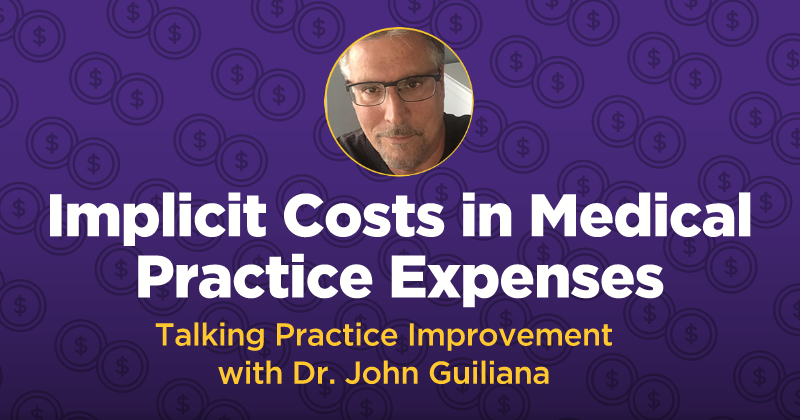Implicit Costs in Medical Practice Expenses

By John V. Guiliana, DPM, MS
Most physicians and managers of a medical practice know exactly where to look to determine what their business costs are: their income statement (profit and loss statement). But what you don’t know about your medical practice’s cost might be hurting you. Let me explain…
In business, there are two types of costs – explicit and implicit. Explicit costs are easily visible and tangible. They are right on your income statement. You are well aware of these costs because you are directly paying for them. But a fairly sizable cost to your medical practice lies hidden in what are known as implicit costs, or opportunity costs. Since you are not directly paying for them, you might not even be aware of them and the toll they are taking on your bottom line.
Consider this hypothetical situation: Your front desk wants extra help answering phones because they are simply overwhelmed at times. Let’s also suppose that hiring an extra set of hands to manage the telephone calls would cost you an additional $35,000 in annual salary. You might easily conclude that the cost of that decision would be $35,000, and the savings associated with not hiring would also be $35,000. But in reality, while the explicit cost of moving ahead with the hire is truly $35,000, the implicit costs associated with not hiring could be hundreds and thousands of dollars! Simply put, you could be losing many patients each year as a result of a poor telephone communication process. The economic loss associated with those patients, as well as patients they might have referred, could be exceedingly great! That dollar amount represents the implicit cost (opportunity cost) of not hiring, and it’s these types of hidden costs that can eat away at your bottom line.
In my experience, the top 3 economic losses as a result of implicit costs in a medical practice are lack of processes, lack of staffing and lack of patient engagement. Each of these deficiencies also takes a toll on patient care and ultimately, the practice’s reputation. I’ll come back to these 3 deficiencies shortly.
In a study performed by the Vanguard Group and published in the Journal of Medical Practice Management, it was found that patients who provided a low rating of their experience with their medical practice, ironically often had very few negative comments about the actual medical care they received.1 Instead, their low rating was as a result of the following:
1) Poor Communication with the practice (53%)
2) Long wait times (35%)
3) Practice staff (12%)
4) Billing (2%)
The deficiencies causing these frequent patient complaints are often the result of poor economic decisions of hiring/not hiring or investing/not investing because the implicit costs are not considered during the decision-making process.
So, let’s revisit what I often find to be the top 3 implicit costs:
Lack of Processes – The implicit cost associated with a lack of documented efficient processes can be substantial. Take a critical look at your most prevalent business processes such as patient scheduling, communication channels, billing, recall, etc., and get them down in a visible flow chart so you can see what needs to be tweaked.
Lack of Staffing – The hypothetical example provided above regarding the front desk’s phone management, clearly demonstrates the enormous cost and poor patient experience associated with this deficiency. In my experience, a practice’s payroll ratio (staff payroll, benefits, and payroll taxes) as a percentage of total revenues seems to operate most efficiently in a range between 22%-28%, depending upon specialty. Naturally, a much higher payroll ratio might indicate waste, but a low payroll ratio can lead to those implicit costs discussed above, leading to poor patient experiences and staff burnout.
Lack of Patient Engagement – In this modern age of medicine, it’s important to use technology to keep patients engaged and maximize the efficiency of many processes, including the registration and patient communication process. Leveraging technology during these and other processes allows patients to interact with the practice, thereby eliminating some internal explicit costs associated with performing these tasks. Patient engagement is one of the fundamental focuses of the suite of solutions offered by ModMed®.
So be aware of your implicit costs because they could be eroding your profitability, many times without you even knowing it!





